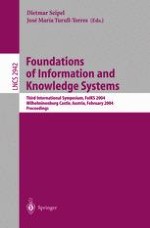2004 | Buch
Foundations of Information and Knowledge Systems
Third International Symposium, FoIKS 2004 Wilheminenburg Castle, Austria, February 17-20, 2004 Proceedings
herausgegeben von: Dietmar Seipel, José María Turull-Torres
Verlag: Springer Berlin Heidelberg
Buchreihe : Lecture Notes in Computer Science
Enthalten in: Professional Book Archive
